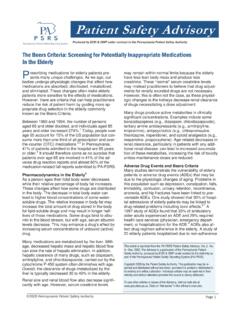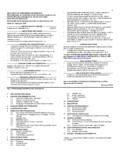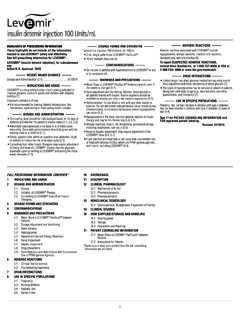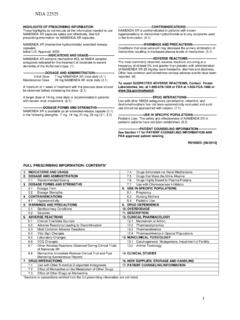Transcription of ANNEX I SUMMARY OF PRODUCT CHARACTERISTICS
1 1 ANNEX I SUMMARY OF PRODUCT CHARACTERISTICS CONFIDENTIAL2 1. NAME OF THE MEDICINAL PRODUCT Epidyolex 100 mg/ml oral solution 2. QUALITATIVE AND QUANTITATIVE COMPOSITION Each ml of oral solution contains 100 mg cannabidiol. Excipients with known effect Each ml of solution contains: 79 mg anhydrous ethanol 736 mg refined sesame oil mg benzyl alcohol For the full list of excipients, see section 3. PHARMACEUTICAL FORM Oral solution Clear, colourless to yellow solution 4.
2 CLINICAL PARTICULARS Therapeutic indications Epidyolex is indicated for use as adjunctive therapy of seizures associated with Lennox-Gastaut syndrome (LGS) or Dravet syndrome (DS), in conjunction with clobazam, for patients 2 years of age and older. Epidyolex is indicated for use as adjunctive therapy of seizures associated with tuberous sclerosis complex (TSC) for patients 2 years of age and older. Posology and method of administration Epidyolex should be initiated and supervised by physicians with experience in the treatment of epilepsy.
3 Posology For LGS and DS The recommended starting dose of cannabidiol is mg/kg taken twice daily (5 mg/kg/day) for one week. After one week, the dose should be increased to a maintenance dose of 5 mg/kg twice daily (10 mg/kg/day). Based on individual clinical response and tolerability, each dose can be further increased in weekly increments of mg/kg administered twice daily (5 mg/kg/day) up to a maximum recommended dose of 10 mg/kg twice daily (20 mg/kg/day). CONFIDENTIAL3 Any dose increases above 10 mg/kg/day, up to the maximum recommended dose of 20 mg/kg/day, should be made considering individual benefit and risk and with adherence to the full monitoring schedule (see section ).
4 For TSC The recommended starting dose of cannabidiol is mg/kg taken twice daily (5 mg/kg/day) for one week. After one week, the dose should be increased to a dose of 5 mg/kg twice daily (10 mg/kg/day) and the clinical response and tolerability should be assessed. Based on individual clinical response and tolerability, each dose can be further increased in weekly increments of mg/kg administered twice daily (5 mg/kg/day) up to a maximum recommended dose of mg/kg twice daily (25 mg/kg/day). Any dose increases above 10 mg/kg/day, up to the maximum recommended dose of 25 mg/kg/day, should be made considering individual benefit and risk and with adherence to the full monitoring schedule (see section ).
5 The dosage recommendations for LGS, DS and TSC are summarised in the following table: Table 1: Dosage recommendations LGS and DS TSC Starting dose first week mg/kg taken twice daily (5 mg/kg/day) Second week Maintenance dose 5 mg/kg twice daily (10 mg/kg/day) 5 mg/kg twice daily (10 mg/kg/day) Further titration as applicable (incremental steps) weekly increments of mg/kg administered twice daily (5 mg/kg/day) Maximal recommended dose 10 mg/kg twice daily (20 mg/kg/day) mg/kg twice daily (25 mg/kg/day) Each Epidyolex carton is supplied with.
6 - Two 1 ml syringes graduated in ml increments (each ml increment corresponds to 5 mg cannabidiol) - Two 5 ml syringes graduated in ml increments (each ml increment corresponds to 10 mg cannabidiol) If the calculated dose is 100 mg (1 ml) or less, the smaller 1 ml oral syringe should be used. If the calculated dose is more than 100 mg (1 ml), the larger 5 ml oral syringe should be used. The calculated dose should be rounded to the nearest graduated increment. Discontinuation If cannabidiol has to be discontinued, the dose should be decreased gradually.
7 In clinical trials, cannabidiol discontinuation was achieved by reducing the dose by approximately 10% per day for 10 days. A slower or faster down titration may be required, as clinically indicated, at the discretion of the prescriber. Missed doses In the case of one or more missed doses, the missed doses should not be compensated. D osing should be resumed at the existing treatment schedule. In the case of more than 7 days missed doses, re-titration to the therapeutic dose should be made. CONFIDENTIAL4 Special populations Elderly Clinical trials of cannabidiol in the treatment of LGS, DS and TSC did not include a sufficient number of patients aged above 55 years to determine whether or not they respond differently from younger patients.
8 In general, dose selection for an elderly patient should be cautious, usually starting at the low end of the dosing range, reflecting the greater frequency of decreased hepatic , renal, or cardiac function, and of concomitant disease or other concurrent therapy (see sections under hepatocellular injury and ). Renal impairment Cannabidiol can be administered to patients with mild, moderate, or severe renal impairment without dose adjustment (see section ). There is no experience in patients with end-stage renal disease.
9 It is not known if cannabidiol is dialysable. hepatic impairment Cannabidiol does not require dose adjustment in patients with mild hepatic impairment (Child-Pugh A). Caution should be used in patients with moderate (Child-Pugh B) or severe hepatic impairment (Child-Pugh C). A lower starting dose is recommended in patients with moderate or severe hepatic impairment. The dose titration should be performed as detailed in the table below. Table 2: Dose adjustments in patients with moderate or severe hepatic impairment hepatic Impairment Starting Dose For LGS, DS and TSC Maintenance Dose For LGS and DS Second Week For TSC Maximal Recommended Dose For LGS and DS Maximal Recommended Dose For TSC Moderate mg/kg twice daily ( mg/kg/day) mg/kg twice daily (5 mg/kg/day) 5 mg/kg twice daily (10 mg/kg/day) mg/kg twice daily ( mg/kg/day) Severe mg/kg twice daily (1 mg/kg/day) 1 mg/kg twice daily (2 mg/kg/day)
10 2 mg/kg twice daily (4 mg/kg/day)* mg/kg twice daily (5 mg/kg/day)* *Higher doses of cannabidiol may be considered in patients with severe hepatic impairment where the potential benefits outweigh the risks. Paediatric population With LGS and DS There is no relevant use of cannabidiol in children aged below 6 months. The safety and efficacy of cannabidiol in children aged 6 months to 2 years have not yet been established. No data are available. With TSC There is no relevant use of cannabidiol in children aged below 1 month.














